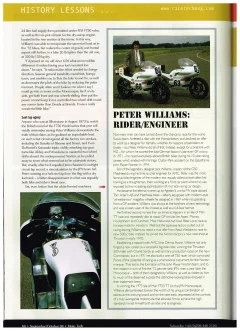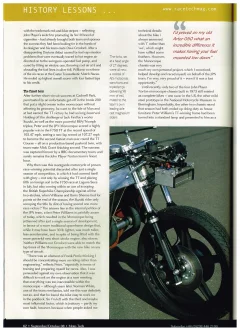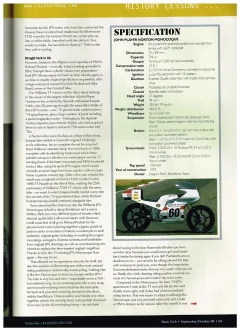madass140 said:
http://ridendrive.it/2017/01/07/la-john-player-norton-f750-del-1973-la-monocoque/
dont know if this has been posted before
I'm taking Gortnipper's suggestion and posting the translated text here (see pics in link) - the translation is a bit weird here and there...
Cheers
Rob
The 1978 John Player Norton F750: The Monocoque
Published on January 7, 2017
The engineer and pilot who created this bike is called Peter Williams, one of the best British riders in the 1960s and 1970s, as well as a strenuous supporter of British motorcycle pride, giving up the tempting offers of Foreign Homes to defend colors of the glorious Norton, who at that time had succeeded in having a massive sponsorship from John Player, an archetype for having supported Lotus for many years in Formula One.
A challenge that, against the Japanese Honda giants, Kawasaki and Suzuki and their latest generation pluricilators, appeared as the legendary biblical clash between David and Goliath. Coupled with the two-stroke long-running two-stroke engine, capable of just over 60 hp on the wheel, Williams was just about to focus on weight, aerodynamics and the driving of his bike, drawing on technical solutions that would then reveal genial intuitions. When, a few years ago, I met Peter Williams in a pub in Norwich, I remember talking to me with special interest in this bike: "The" Monocoque "was without doubt the best bike I took on track, the one on which I poured all the my pilot experience and my ideas as a designer. And he paid me, allowing me to win the Tourist Trophy in the 1977 F750 class, a great satisfaction for me and Norton. "
The use of the monocoque structure applied to a racing bike was not an absolute novelty in those years. We remember the Grand Prix 250 bones that in 1969/70 came to light with Santiago Herrero, the great Spanish talent driver - and courage - who in 1969 contended until the end of the world title at Kel Carruthers and Benelli four cylinders. And then there was also the Kawasaki 500 H1R set up by Eric Offenstadt. But those monocoque were basically based on a torsionally high-strength boxed structure similar to those of Formula 1 cars, which in turn were derived from riveted aluminum sheet metal constructions.
Williams had the ingenious intuition to create a pair of parallel boxed structures between which the engine was placed: "I was inspired by an old Arter-Matchless in which we had mounted two sheet metal tanks on the hips to lower the center of gravity and the driving position. A solution we had adopted on the Norton F750 in 1971. I thought they could be excellent structural elements. " The draft was submitted to Frank Perris, Team Manager and John McLaren, the technician who could shape this idea. Both were immediately excited and ready to start. Made of thin electrowelded stainless steel sheet, the two boxes departed from the steering sleeve and dropped to the height of the swingarm pin. In this way the stiffness had even increased and, keeping the gas inside, kept the center of gravity low. Today, commonly referred to aluminum perimeter structures, such as the famous Yamaha Deltabox. The Norton chassis, forty years ago, had a very similar structure. And this is what makes Williams particularly proud of his work: to get ahead of time, with an intuition that is probably run by a large motorcycle house will advance new horizons in the chassis both for racing and standard racing. But at that time, the Houses invested in cubic centimeters, the number of cylinders and horses, or the one that most lured the appetite and imagination of the customers. A low, lightweight, manoeuvrable, but with a few horses was certainly not in their wishes. Today, fortunately, we are a bit contorted, but in the '70s it was so ... The bicycle was completed by a fork with magnesium alloy sheaths on which the Lockeed clamps were made and stems derived from those of the contemporary AJS Stormer by motocross. The front brake discs, cast iron, had a diameter of 10 "(254 mm). The rear brake was also a single disc with a diameter of 8 "(204 mm). The 5-spoke 18 "spokes (2 1/4" front channel, 3 "rear) were cast in magnesium alloy.
The short sporting career
After a brilliant start at Daytona, the 'Monocoque' have three statements in the races scheduled for the Anglo-American Match Race, which was held in spring in England. This was a very important event since he compared the English and American schools in a series of gare-sprints on some short English circuits. But Peter Williams's masterpiece was the victory in the TT class F750 at an average of 105.47 miles (nearly 170 km / h) ahead of Mick Grant with the same bike. The seal to his masterpiece.
The Norton Monocoque lasted, unfortunately, only one season. In 1974, it was replaced by a more conventional version, with the trunk frame (the so-called Space Frame), which turned out to be a little lower, so that, despite the slightest weight and even slightly higher engine power, neither Williams nor the courageous Dave Croxford managed to improve the time taken to score with the previous one. A bike that no longer reflected the construction philosophy of the Monocoque and on which Williams never found himself comfortable. A tough break that broke off at Oulton Park, with a fall that closed the British pilot career. It was the last of the classic Norton races.
The Replica
The author of this wonderful "replica" is Norbert Prokschi, a German gentleman with unquestionable technical skills that with a little unconscious has launched into this enterprise: "I absolutely wanted to have one of these bikes, and since I knew I would not be able to buy the original, I decided that I would build it with my hands ... ". Prokschi used constructive techniques similar to the originals, also because the Norton racing department wishing to challenge Japanese giants in the 1970s was just over a craft workshop ...






